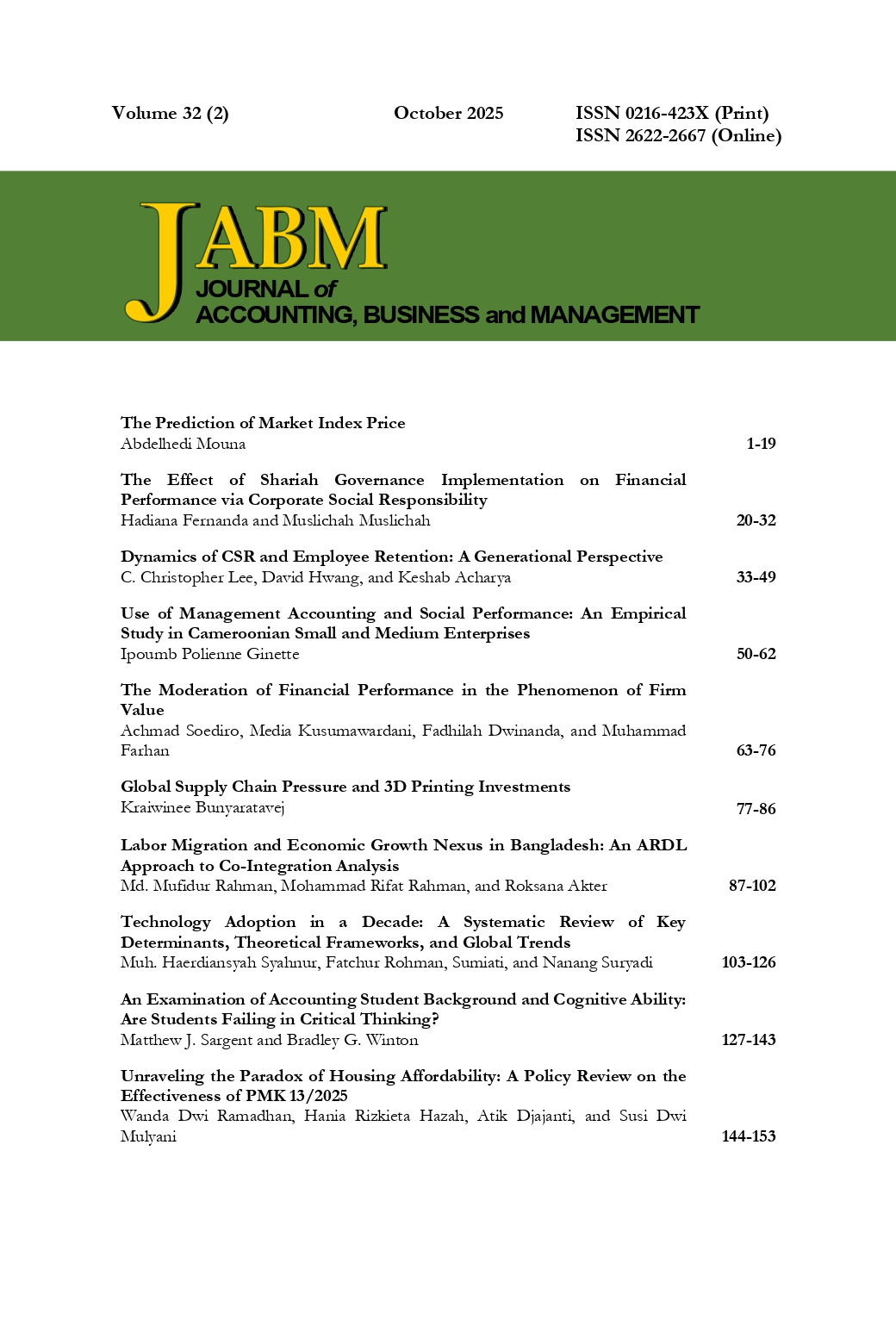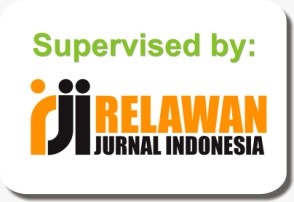Global Supply Chain Pressure and 3D Printing Investments
Abstract
Recent events such as the pandemic have shed some light on the vulnerability of the global supply chains when they are greatly disrupted. Some firms opt to increase their in-house capacity, while some businesses resort to sourcing locally. Technology, which had been used to increase efficiency of firms, became even more important in solving and preventing supply chain risks by increasing flexibility in sourcing. 3D printing has played an important role in relieving some of the pressure from businesses. Hence, businesses might not have to choose between improving efficiency by producing or sourcing where it is cheap versus improving security by sourcing or bringing facilities closer to home. In this paper, the aim is to shed some light on the impact of global supply chain problems on investments into 3D printing start-ups. Using a Poisson regression model for investigating the hypotheses, we found that as pressure has built on the supply chains, businesses made more investments in the 3D printing technology in order to navigate through the volatility. The future research could expand to cover more technology and time period. We hope that the paper will highlight the importance of 3D printing technology in businesses when supply chain disruption occurs
Downloads
References
Bier, T., Lange, A., & Glock, C. H. (2020). Methods for mitigating disruptions in complex supply chain structures: A systematic literature review. _International Journal of Production Research_, _58_(6), 1835-1856. Doi: 10.1080/00207543.2019.1687954.
Chen, J., Sohal, A. S., & Prajogo, D. I. (2013). Supply chain operational risk mitigation: A collaborative approach. _International Journal of Production Research_, _51_(7), 2186-2199. Doi: 10.1080/00207543.2012.727490.
Choong, Y. Y. C., Tan, H. W., Patel, D. C., Choong, W. T. N., Chen, C. H., Long, H. Y., Tan, M. J., Patel, C. D., & Chua, C. K. (2020). The global rise of 3D printing during the Covid-19 pandemic. _Nature Review Materials_, _5_, 637-639. https://doi.org/10.1038/s41578-020-00234-3.
Coase, R. H. (1937). The nature of the firm. _Economica_, _4_(16), 386-405. https://doi.org/10.1111/j.1468-0335.1937.tb00002.x.
Dossani, R., & Kenney, M. (2007). The next wave of globalization: Relocating service provision to India. _World Development_, _35_(5), 772-791. https://doi.org/10.1016/j.worlddev.2006.09.014.
Durach, C. F., Kurpjuweit, S., & Wagner, S. M. (2017). The impact of additive manufacturing on supply chains. _International Journal of Physical Distribution & Logistics Management_, _47_(10), 954-971. https://doi.org/10.1108/IJPDLM-11-2016-0332.
Forger, G. (2019, March 21). 3-D printing moves out of the hype cycle. _Supply Chain Management Review_. Retrieved from https://www.scmr.com/article/3_d_printing_moves_out_of_the_hype_cycle.
FRBNY (Federal Reserve Bank of New York). (2022a). Global supply chain pressure index (GSCPI). Retrieved August 15, 2022, from https://www.newyorkfed.org/research/policy/gscpi#!/overview.
FRBNY (Federal Reserve Bank of New York). (2022b). _New York fed launches global supply chain pressure index_. Press Releases. Retrieved October 12, 2022, from https://www.newyorkfed.org/newsevents/news/research/2022/20220518.
Garfield, L. (2017, March 4). _This robot can 3D-print and bake a pizza in six minutes_. Retrieved October 20, 2022, from https://www.businessinsider.com/beehex-pizza-3d-printer-2017-3.
Golan, M. S., Jernegan, L. H., & Linkov, I. (2020). Trends and applications of resilience analytics in supply chain modeling: Systematic literature review in the context of the Covid-19 pandemic. _Environment Systems & Decisions, 40_, 222-243. https://doi.org/10.1007/s10669-020-09777-w.
Hahn, E. D., & Massini, S. (2024). Cross-border and domestic early-stage financial investment in 3D printing: An empirical perspective on drivers and locations. _Journal of International Management, 30_(5), 101172. https://doi.org/10.1016/j.intman.2024.101172.
Hendricks, K. B., & Singhal, V. R. (2005). An empirical analysis of the effect of supply chain disruptions on long-run stock price performance and equity risk of the firm. _Production & Operations Management, 14_(1), 35-52. https://doi.org/10.1111/j.1937-5956.2005.tb00008.x.
Kermeliotis, T. (2014). Futuristic drive: Step inside a 3D printed car. Retrieved from https://www.cnn.com/2014/06/26/tech/futuristic-drive-step-inside-3d/index.html. Accessed January, 10, 2024.
Khan, S. A. R., Waqas, M., Honggang, X., Ahmad, N., & Yu, Z. (2022). Adoption of innovative strategies to mitigate supply chain disruption: Covid-19 pandemic. _Operation Management Research, 15_, 1115–1133. https://doi.org/10.1007/s12063-021-00222-y.
Kwak, D. -W., Seo, Y. -J., & Mason, R. (2018). Investigating the relationship between supply chain innovation, risk management capabilities and competitive advantage in global supply chains. _International Journal of Operations & Production Management, 38_(1), 2-21. https://doi.org/10.1108/IJOPM-06-2015-0390.
Laplume, A. O., Petersen, B., & Pearce, J. M. (2016). Global value chains from a 3D printing perspective. _Journal of International Business Studies, 47_(5), 595-609. https://doi.org/10.1057/jibs.2015.47.
Manning, S., Massini, S., Peeters, C., & Lewin, A. Y. (2018). The changing rationale for governance choices: Early vs. late adopters of global services sourcing. _Strategic Management Journal, 39_(8), 2303-2334. https://doi.org/10.1002/smj.2795.
Marić, J., Opazo-Basáez, M., Vladíč, B. & Dabić, M. (2023). Innovation management of three-dimensional printing (3DP) technology: Disclosing insights from existing literature and determining future research streams. _Technological Forecasting & Social Change, 193_, 122605. https://doi.org/10.1016/j.techfore.2023.122605.
Menon, K., Kárkkäinen, H., & Wuest, T. (2020). Industrial internet platform provider and end-user perceptions of platform openness impacts. _Industry & Innovation, 27_(4), 363-389. https://doi.org/10.1080/13662716.2019.1673150.
Mohr, S., & Khan, O. (2015). 3D printing and its disruptive impacts on supply chains of the future. _Technology Innovation Management Review, 5_(11), 20-25. Doi: 10.22215/timreview/942.
Moosavi, J., Fathollahi-Fard, A. M., & Dulebenets, M. A. (2022). Supply chain disruption during the Covid-19 pandemic: Recognizing potential disruption management strategies. _International Journal of Disaster Risk Reduction, 75_, 102983. https://doi.org/10.1016/j.ijdrr.2022.102983.
Niranjan Y. C, Channabasavanna S. G., Krishnapillai S., Velmurugan R., Kannan A. R., Mohan G. D., & Karganroudi S. S. (2022). The unprecedented role of 3D printing technology in fighting the Covid-19 pandemic: A comprehensive review. _Materials, 15_(19), 6827. Doi: 10.3390/ma15196827.
Öberg, C., Shams, T., & Asnafi, N. (2018). Additive manufacturing and business models: Current knowledge and missing perspectives. _Technology Innovation Management Review, 8_(6), 15-33. Doi: 10.22215/timreview/1162.
Oldekop, J. A., Horner, R., Hulme, D., Adhikari, R., Agarwal, B., Alford, M., Bakewell, O., et al. (2020). Covid-19 and the case for global development. _World Development, 134_, 105044. https://doi.org/10.1016/j.worlddev.2020.105044.
Peron, M., Sgarbossa, F., Ivanov, D., & Dolgui, A. (2022). Impact of additive manufacturing on supply chain resilience during Covid-19 pandemic. In: A. Dolgui, D. Ivanov, & B. Sokolov (Eds.), _Supply network dynamics and control_ (pp. 165-183). Springer. https://doi.org/10.1007/978-3-031-09179-7_6.
Rayna, T., & Srinikova, L. (2021). Assessing the effect of 3D printing technologies on entrepreneurship: An exploratory study. _Technological Forecasting & Social Change, 164_, 120483. https://doi.org/10.1016/j.techfore.2020.120483.
Riddalls, C. E., & Bennett, S. (2002). Production-inventory system controller design and supply chain dynamics. _International Journal of Systems Science, 33_(3), 181-195. Doi: 10.1080/00207720110092180.
Rose, J., Lukic, V., Milon, T., & Cappuzzo, A. (2016, December 8). _Sprinting to value in industry 4.0_ (pp. 1-10). The Boston Consulting Group. https://r3ilab.fr/wp-content/uploads/2017/01/BCG-Sprinting-to-Value-in-Industry-4-0-Dec-2016.pdf.
Scheibe, K. P., & Blackhurst, J. (2018). Supply chain disruption propagation: A systemic risk and normal accident theory perspective. _International Journal of Production Research, 56_(1-2), 43-59. Doi: 10.1080/00207543.2017.1355123.
Shanker, N. (2020, August 3). _Resiliency, not a revolution: How 3D printing will change global supply chains_. Forbes. Retrieved October 13, 2022, from https://www.forbes.com/councils/forbestechcouncil/2020/07/08/resiliency-not-a-revolution-how-3d-printing-will-change-global-supply-chains/.
Shen, Z. M., & Sun, Y. (2021). Strengthening supply chain resilience during Covid-19: A case study of JD.com. _Journal of Operations Management, 69_(3), 359-383. https://doi.org/10.1002/joom.1161.
Sherman, E. (2020, February 21). _94% of the fortune 1000 are seeing coronavirus supply chain disruptions: Report_. Retrieved October 19, 2023, from https://fortune.com/2020/02/21/fortune-1000-coronavirus-china-supply-chain-impact/.
Singh, S., Kumar, R., Panchal, R., & Tiwari, M. K. (2021, April). Impact of Covid-19 on logistics systems and disruptions in food supply chain. _International Journal of Production Research, 59_(7), 1993-2008. Doi: 10.1080/00207543.2020.1792000.
Smart, S. (2021, December 27). Virginia family gets keys to habitat for humanity's first 3D-printed home in the US. CNN. Retrieved January 10, 2024, from https://www.cnn.com/2021/12/26/us/habitat-for-humanity-first-3d-home-tmd/index.html.
Strange R., & Zucchella A. (2017). Industry 4.0, global value chains and international business. _Multinational Business Review, 25_(3), 174-184. https://doi.org/10.1108/MBR-05-2017-0028.
Tang, C. S. (2006). Perspectives in supply chain risk management. _International Journal of Production Economics, 103_(2), 451-488. https://doi.org/10.1016/j.ijpe.2005.12.006.
The White House. (2022, May 9). _Using additive manufacturing to improve supply chain resilience and bolster small and mid-size firms_. Retrieved October 12, 2022, from https://bidenwhitehouse.archives.gov/cea/written-materials/2022/05/09/using-additive-manufacturing-to-improve-supply-chain-resilience-and-bolster-small-and-mid-size-firms/.
Tukamuhabwa, B. R., Stevenson, M., Busby, J., & Zorzini, M. (2015). Supply chain resilience: Definition, review and theoretical foundations for further study. International Journal of Production Research, 53(18), 5592-5623. https://doi.org/10.1080/00207543.2015.1037934.
UNCTAD. (2021). World investment report 2021: Investing in sustainable recovery. New York: United Nations Publications. https://unctad.org/system/files/official-document/wir2021_en.pdf.
Wakolbinger, T., & Cruz, J. M. (2010). Supply chain disruption risk management through strategic information acquisition and sharing and risk-sharing contracts. International Journal of Production Research, 49(13), 4063-4084. Doi: 10.1080/00207543.2010.501550.
Williamson, O. E. (1985). The economic institutions of capitalism. New York: The Free Press.
Wu, T., Blackhurst, J., & O'Grady, P. J. (2007). Methodology for supply chain disruption analysis. International Journal of Production Research, 45(7), 1665-1682. https://doi.org/10.1080/00207540500362138.














